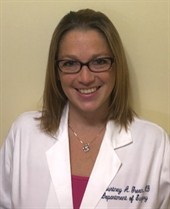Investigation into the Perceptual Expertise of a Robotic Surgeon: How do we learn to feel what we see?
 Principal Investigator
Principal Investigator
Courtney A. Green, M.D.
Resident Research Fellow
Surgical Education Pathway
The growth of robotic technology in the field of general surgery has been exponential. In 2016, at academic centers alone, surgeons performed nearly 18,000 general surgery cases using this technology. Unfortunately, the integration of robotics into surgical training has proved challenging. The robotic learning environment is unique and complex. First, it requires decreased dependency on resident assistance, which traditionally is how residents learn. Second, the surgeon is physically at a distance from the resident. Third, there is no tactile feedback so residents must acquire perceptual expertise. Although residents currently are exposed to an increasing number of robotic procedures, their participation is often limited to observation only. And even that observation requires new skills to observe both the robot and the surgical field. Without new methods of teaching, a dangerous gap in technical proficiency will emerge in the next generation of surgical trainees.
Today’s robotic technology lacks haptic feedback, requiring robotic surgeons to rely entirely on visual processing to interpret what is happening in the operative field. Interestingly, many expert robotic surgeons report that despite a lack of tactile feedback, they can still “feel what they see.”1 How can the robotic surgeon convey this sense to trainees? There is a critical need to describe how surgeons use words, gestures, and vocalizations to communicate how they feel what they can only see and how elements of their perceptual expertise guide intraoperative decision-making.
To address this challenge, we draw from relevant cognitive sciences theories. Perceptual learning describes experience-induced modifications in the way we extract perceived information. Using a continuous perception-action loop, learners develop goal-driven behavior known as perception for action2. Professional vision3 describes the practices that help novices build disciplined ways of seeing events and understanding their implications for practice. Using perception for action and professional vision, learners gain perceptual expertise, often seen as the logical endpoint of the normal trajectory of learning (perceptual learning) in a domain-specific environment.
Studies support the notion that perceptual expertise is gained with surgical experience and correlates with skill mastery.4,5 Given the lack of haptic feedback and dependence on visual information guiding operative decisions in robotic surgery, understanding how to develop perception for action is essential to gaining robotic skill mastery. Teaching strategies can also be limited by the expert blind spot;6 when a skilled individual no longer has conscious access to, or appreciation of, their own know-how underlying their competence. Consequently, experts cannot begin to articulate, let alone teach, that skill to novices.
Perceptual learning is pervasive in surgical training—residents develop technical and cognitive skills reciprocally and in situated context. Licensure, as regulated by The American Board of Surgery, requires completion of a defined number of surgical cases (or situated contexts). Although perceptual learning is widely accepted in surgical education, focused instruction using this framework has been absent. So, how do expert robotic surgeons articulate their perception? Language and gestures are essential for instruction, and develop within a context. We believe that through study of the robotic context, we can elicit language and associated gestures from surgeons. We then can use the findings to design teaching strategies to expedite development of perceptual expertise.
Specific Aims
Our goal is to investigate the components of perceptual expertise in expert robotic surgeons to identify verbal or non-verbal (gestures) language that allows them to feel what they see during robotic surgery. To accomplish our goal, we have designed two specific aims:
- To support that perceptual expertise correlates with mastery, determine if there is a difference in perceptual expertise between experts and residents as measured by time to recognize errors.
- Identify the verbal and non-verbal language expert robotic surgeons use to communicate operative decision-making clarifying how they feel what they can only see.
Using results from this study we can help develop faculty’s ability to teach in this new environment and foster perceptual expertise, ultimately to improve resident acquisition of essential skills.
Sources
- Chang, George; Garcia-Aguilar, Julio; Larson D. 3M Colorectal Cancer Robotics Surgery Symposium. In: Hosted by Dr. George Chang and MD Anderson Cancer Center. Houston, TX; 2016.
- Gibson JJ. The theory of affordances. In: Shaw R, Bransford J, eds. Perceiving, Acting and Knowing: Toward an Ecological Psychology. Hillsdale, NJ: Lawrence Erlbaum Associates; 1977:67-82.
- Goodwin C. Professional Vision. Am Anthropol. 1994;96(3):606-633. doi:10.1525/aa.1994.96.3.02a00100.
- Abdelsattar JM, Pandian TK, Finnesgard EJ, et al. Do You See What i See? How We Use Video as an Adjunct to General Surgery Resident Education. J Surg Educ. 2015;72(6):e145-e150. doi:10.1016/j.jsurg.2015.07.012.
- Dominguez CO, Flach JM, McKellar DP, Dunn M. Using videotaped cases to elicit perceptual expertise in laparoscopic surgery. Third Annu Symp Hum Interact with Complex Syst HICS’96. 1996:116-123. doi:10.1109/HUICS.1996.549501.
- Nathan MJ, Koedinger KR, Alibali MW. Expert blind spot: When content knowledge eclipses pedagogical content knowledge. Proceeding Third Int Conf Cogn Sci. 2001:644–648. http://www.colorado.edu/ics/sites/default/files/attached-files/00-05.pdf.